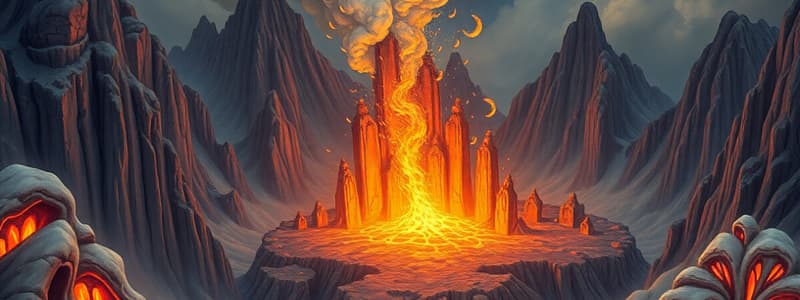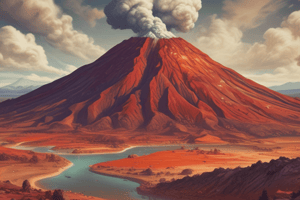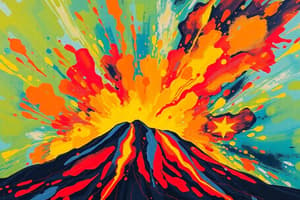Podcast
Questions and Answers
What type of materials are primarily emitted during volcanic eruptions?
What type of materials are primarily emitted during volcanic eruptions?
- Only gases
- Gases, liquids, and solids (correct)
- Only solid materials
- Only liquids and gases
Which of the following is a source of energy harnessed from volcanic activity?
Which of the following is a source of energy harnessed from volcanic activity?
- Wind energy
- Geothermal energy (correct)
- Solar energy
- Nuclear energy
What is a significant environmental benefit of harnessing volcanic energy?
What is a significant environmental benefit of harnessing volcanic energy?
- It is not a renewable resource.
- It causes irreversible land damage.
- It decreases reliance on fossil fuels. (correct)
- It produces significant greenhouse gases.
Which of the following is NOT typically emitted from volcanic eruptions?
Which of the following is NOT typically emitted from volcanic eruptions?
Why is geothermally harnessed energy considered environmentally friendly?
Why is geothermally harnessed energy considered environmentally friendly?
What is the most common gaseous material released during a volcanic eruption?
What is the most common gaseous material released during a volcanic eruption?
What is a primary challenge in utilizing volcanic energy?
What is a primary challenge in utilizing volcanic energy?
Which of these phenomena is most likely to occur following a volcanic eruption?
Which of these phenomena is most likely to occur following a volcanic eruption?
What role does volcanic ash play in the ecosystem post-eruption?
What role does volcanic ash play in the ecosystem post-eruption?
Which of the following is NOT a method for harnessing geothermal energy?
Which of the following is NOT a method for harnessing geothermal energy?
What are potentially active volcanoes monitored for?
What are potentially active volcanoes monitored for?
What defines an extinct volcano?
What defines an extinct volcano?
Which of the following best describes dormant volcanoes?
Which of the following best describes dormant volcanoes?
Why is a classification system important for volcanic activity?
Why is a classification system important for volcanic activity?
How are eruptions typically classified?
How are eruptions typically classified?
What was observed during the dissimilar eruptions in the volcano experiment?
What was observed during the dissimilar eruptions in the volcano experiment?
What factor might account for differences in eruption speed during experiments?
What factor might account for differences in eruption speed during experiments?
What does an eruption column's height indicate?
What does an eruption column's height indicate?
Which statement accurately describes the Benham Rise?
Which statement accurately describes the Benham Rise?
What does the Plate Tectonics theory indicate about tectonic processes?
What does the Plate Tectonics theory indicate about tectonic processes?
What geological phenomena occurs at divergent boundaries?
What geological phenomena occurs at divergent boundaries?
What is a primary cause of decompression melting at convergent boundaries?
What is a primary cause of decompression melting at convergent boundaries?
What differentiates lava from magma?
What differentiates lava from magma?
Why is volcanism linked to mass extinctions caused by Large Igneous Provinces (LIPs)?
Why is volcanism linked to mass extinctions caused by Large Igneous Provinces (LIPs)?
What is the main structural difference of volcanoes based on their types?
What is the main structural difference of volcanoes based on their types?
What is a characteristic of a dome-shaped volcano?
What is a characteristic of a dome-shaped volcano?
Flashcards
Potentially active volcanoes
Potentially active volcanoes
Volcanoes that have erupted in the past and are likely to erupt again.
Extinct volcanoes
Extinct volcanoes
Volcanoes that have not erupted in the past 10,000 years and are unlikely to erupt again.
Dormant volcanoes
Dormant volcanoes
Volcanoes that have not erupted in the recent past but are likely to erupt again in the future.
Volcanic activity classification system
Volcanic activity classification system
Signup and view all the flashcards
Volcanic Eruption
Volcanic Eruption
Signup and view all the flashcards
Volcano
Volcano
Signup and view all the flashcards
Shield Volcano
Shield Volcano
Signup and view all the flashcards
Composite Volcano
Composite Volcano
Signup and view all the flashcards
Volcanic Dome
Volcanic Dome
Signup and view all the flashcards
Caldera
Caldera
Signup and view all the flashcards
Volcanic Fissure
Volcanic Fissure
Signup and view all the flashcards
Active Volcanoes
Active Volcanoes
Signup and view all the flashcards
Inactive Volcanoes
Inactive Volcanoes
Signup and view all the flashcards
Harnessing Volcanic Energy
Harnessing Volcanic Energy
Signup and view all the flashcards
What are LIPs?
What are LIPs?
Signup and view all the flashcards
Is the Benham Rise an example of a LIP?
Is the Benham Rise an example of a LIP?
Signup and view all the flashcards
Is the Yellowstone Caldera an example of an ocean island basalt?
Is the Yellowstone Caldera an example of an ocean island basalt?
Signup and view all the flashcards
What does the Plate Tectonics theory state?
What does the Plate Tectonics theory state?
Signup and view all the flashcards
What happens at divergent boundaries?
What happens at divergent boundaries?
Signup and view all the flashcards
What happens at convergent boundaries?
What happens at convergent boundaries?
Signup and view all the flashcards
Is volcanism possible without high amounts of heat?
Is volcanism possible without high amounts of heat?
Signup and view all the flashcards
Why are most Philippine volcanoes part of island arcs?
Why are most Philippine volcanoes part of island arcs?
Signup and view all the flashcards
Study Notes
Unit 15: Understanding Volcanoes
- Volcanoes are openings in the Earth's surface where magma, pyroclastic materials, and gases erupt.
- Volcanism is the process where magma rises to the surface and becomes lava.
- Volcanoes are classified based on their structure (e.g., shield volcanoes, composite volcanoes, cinder cones) and activity (e.g., active, potentially active, inactive).
- Volcanic activity varies and is not always in the form of a mountainous landform.
- Different plate boundaries (divergent, convergent, transform) are associated with different types of volcanism,.
- Magma is molten rock material located beneath the surface.
- Lava is magma that reaches the Earth's surface.
- Magmas and lavas have different compositions and viscosities, influencing their eruptive style.
- Eruptions can be effusive (producing lava flows) or explosive (producing pyroclastic debris).
- Eruptions are classified by their style, explosivity, and volume of debris, and the height of the resulting eruption column.
- Eruptions can be driven by thermal expansion of dissolved gases in lava, or by interaction with water.
- Volcanic eruptions release various materials such as lava, pyroclastic debris, gases, and ash.
- The Philippines has a high amount of volcanic activity due to its location in the "Ring of Fire."
- PHIVOLCS is the agency responsible for monitoring volcanoes in the Philippines and uses a classification system for this purpose.
- The four most active volcanoes in the Philippines are Mt. Kanlaon, Mt. Bulusan, Taal Volcano, and Mayon Volcano.
- There are 23 active volcanoes currently monitored by PHIVOLCS.
- The Philippines has 281 inactive volcanoes.
- The geothermal system is a confined area where groundwater transfers heat from a heat source to a heat sink and is the basis for energy exploitation.
- There are currently 8 geothermal plants in the Philippines.
- Geothermal energy is an attractive business venture.
Studying That Suits You
Use AI to generate personalized quizzes and flashcards to suit your learning preferences.




